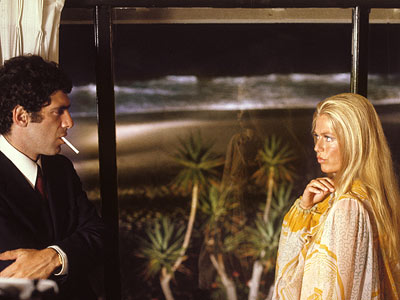The Long Goodbye/1973/United Artists/112 min.
One of the best films of the ’70s or an ugly, boring travesty of a well respected detective novel?
Decide for yourself as you watch Robert Altman’s 1973 movie of “The Long Goodbye,” by Raymond Chandler. The film, starring Elliott Gould as private investigator Philip Marlowe, divided critics, earning the above-mentioned rave from Time Out and the snooty slam from Leslie Halliwell.
It was primarily Gould’s free-wheeling interpretation of the beloved PI that drew ire. Charles Champlin called him an “untidy, unshaven, semi-literate dimwit slob.”
An entertaining yarn, soaked in ’70s atmosphere, the movie captures the sunny, scruffy, solipsistic mood and look of Malibu, Calif., at the start of the Me Decade. Marlowe’s next door neighbors, for example, are pot-brownie-baking, clothing-optional candlemakers. We only see them from a distance but in a way they are timeless party girls, a ’70s version of “The Girls Next Door.”
And “The Long Goodbye” stretches the vocabulary of film noir. As Foster Hirsch, author of “Detours and Lost Highways: A Map of Neo Noir,” writes: “For all its self-indulgence and contradiction – the film both satirizes and seeks acceptance as a cool, contemporary L.A. mystery story – Altman’s ‘new age’ noir suggested the genre’s elasticity at a time when it was considered passé. Produced before nouveau noir had taken root, ‘The Long Goodbye’ anticipates the full-force genre revival of the 1980s and 1990s.”
We meet Marlowe late one night as he’s trying to round up food for his hungry cat (Morris the Cat in the role that launched him to stardom). The story spices up when Marlowe’s friend Terry Lennox (Jim Bouton) asks him, after a marital spat, to drive him to Tijuana.
Marlowe doesn’t have much else going on (besides cat care, of course) and so they make the trip; Marlowe heads back on his own to find that Lennox’s wife is dead. The police press Marlowe for info on Terry’s whereabouts, hoping that a little jail time will jog his memory (David Carradine plays Marlowe’s cellmate). They ease up after Terry Lennox commits suicide, having first written a letter confessing to the murder.
Marlowe’s not buying the suicide, but turns his attention to a new client. The sun-kissed and sophisticated Eileen Wade (Nina van Pallandt) wants Marlowe to find her missing hubby Roger Wade, a boozy writer, (played by the wonderful Sterling Hayden, a veteran of film noirs like “Asphalt Jungle” and “The Killing”).
Searching for Roger isn’t all that challenging, but Marlowe has his hands full with a visit from psychopathic gangster Marty Augustine (director Mark Rydell) and his hoods (including young Arnold Schwarzenegger). They’re sniffing around for a load of cash that Terry Lennox was supposed to deliver to Mexico. Surprise, surprise, the cash never made it. So the surly, anti-social Marlowe plods on toward the truth, trying not to get any sand on the shag carpets.
Was Altman satirizing classic ’40s flicks with “The Long Goodbye”? I don’t think so. First, the script comes from the famous pen of Leigh Brackett, who co-wrote “The Big Sleep” (1946), a landmark noir based on another Raymond Chandler novel with Philip Marlowe, directed by Howard Hawks, and starring Humphrey Bogart and Lauren Bacall. Why would Brackett trash her brand and Altman trash one of his favorite directors? And the controversial ending, not in the novel? That was Brackett’s idea, not Altman’s.
Of course, it’s ultimately Altman’s film. But rather than settle for pastiche or parody, Altman aimed to adapt an older framework for a more contemporary setting and create something original. That meant following his own singular vision.
Other enticements: The stunning cinematography by Vilmos Zsigmond, especially the scene where Marlowe waits on the beach while Mrs. and Mrs. Wade have a private chat. Altman’s trademark overlapping dialogue works really well in this flick as does the music by John Williams and Johnny Mercer. (“Hooray for Hollywood!”)
Also, Altman let Gould play Marlowe as a grumpy, hungover loner. But like his predecessors (most famously Bogart), Gould’s Marlowe is just about as cynical and detached as any of them. And he exacts justice based on his own moral code.
It’s just that he doesn’t look very clean while he’s doing it. Marlowe doesn’t have freshly starched shirts. His place is a sty. He’s disorganized. He also talks to himself and chain smokes. But with soaring ’70s inflation, Marlowe probably couldn’t spring for a secretary or housekeeper.
Compare that with Bogart’s Sam Spade and his efficient and loyal sidekick Effie Perine (Lee Patrick) in “The Maltese Falcon” (1941). Effie rocked. So cut Gould’s Marlowe a little slack – who among us couldn’t benefit from a maid and personal assistant?











From FNB readers